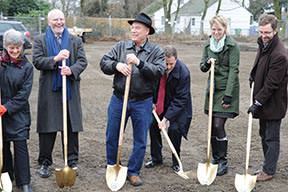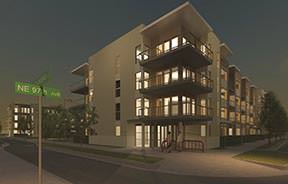 |
||||||||
| MEMO BLOG | Memo Calendar | Memo Pad | Business Memos | Meals on Wheels | Letters | Home | ||
LINDA CARGILL
THE MID-COUNTY MEMO
 |
| A kaleidoscope of government officials joins developer Gordon Jones for groundbreaking at the Rose Apartments complex. From left, Metro Councilors Carlotta Collette and Bob Stacey, Jones, Portland Bureau of Transportation's Director of Local Improvement District Andrew Aebi, Metro's Transit-Oriented Development Program Director Megan Gibb, and Portland Development Commission Policy Manager Justin Douglas. Mid-county Memo photo/Tim Curran |
 |
| The Rose, a new, 90-unit mixed-income apartment complex at 328 N.E. 97th Ave. in the Gateway Regional Center Urban Renewal Area broke ground last month. Developer Gordon Jones said it would take about a year to build it. Mid-county Memo photo/Tim Curran |
The new, 90-unit apartment complex had four different monikers in the years it took planning, financing and government entities cooperating before Jones settled on the Rose.
Now, on a cold winter day, he stood holding a shovel, about to break ground on his long-awaited project at 328 N.E. 97th Ave. in the Gateway Regional Center urban renewal area.
He looked at the plethora of public officials, bankers and builders gathered around him like proud relatives at a christening. Referring to property owners along 97th Avenue that participated in it as part of the project Jones said, “The property owners that formed this LID (Local Improvement District) have been really amazing; and all the public outreach that kept this project going and made all this happen,-I really appreciate all that.”
After the celebration, Jones told the Memo he envisioned the project in 2004 but postponed it several times when the housing market crashed and funding was scarce; however, he never gave up on building his mixed-income complex. He worked with several government bureaus, borrowed from a bank, and donated a right of way worth more than $140,000.
In an ebullient mood at the groundbreaking, Jones continued to thank individuals and bureaus that created a public-private partnership to fund the $10.5 million project. He singled out Portland Development Commission's (PDC) Justin Douglas, who was “instrumental in getting the grants for the street improvement,” Jones said, as well as PDC's Sue Lewis, Andrew Aebi at the Portland Bureau of Transportation (PBOT), Meganne Steele and Megan Gibbs at Metro, and many others.
Following Jones and other officials, Bob Stacey, the Metro councilor representing east Portland addressed the assembled, applauding Jones for creating the Rose, which so closely matches Metro's design plans for Gateway.
“In Portland and across the region, Gateway's success is our success,” Stacey said, as noon-hour traffic roared past him on 97th Avenue. “This is a critical regional center. Metro put it in the Regional Plan as one of nine regional centers where we would have housing, employment and retail opportunities to serve the surrounding neighborhoods.”
He said the two four-story apartment buildings,-Rose East and Rose West-will mirror each other, one facing 97th Avenue, and the other facing 99th Avenue, each containing 45 units, with 40 percent low-income apartments, the rest at market rate, the kind of affordable housing the Regional Plan desired.
“It's very difficult to get financial stability in the Gateway area,” Jones explained. “The cost of development out here is just high in comparison to the market rents that you can achieve, so this project has a lot of different parts to it.”
He noted development costs not only included helping fund the new street, but also paying to demolish two old homes with garages, and a commercial building in 2012.
As the apartment project evolved, Jones and his team of planners added new improvements to surrounding streets. Originally, only improvements to 97th Avenue were considered, but later 100 percent of local property owners along the street agreed to form an LID to cover part of the costs of the street improvements. With the LID in place, planners not only extended improvements further south on Northeast 97th Avenue, but also created a new street,-Northeast Everett Court-connecting Northeast 97th and 99th avenues, and added underground street lighting improvements.
Andrew Aebi, the LID administer for PBOT and project manager for the Rose development, said the original budget of $1,157,000 ballooned to the current $1,423,355 to cover the improvements.
The additional money is coming from the Oregon Department of Transportation, the LID formed by property owners, and PBOT, which used System Development Charges (SDC), according to Aebi. PBOT was able to offer SDC funding because of the additional capacity provided by the new Northeast Everett Court connection. “Most local connections do not provide additional capacity to the transportation system and are therefore not eligible for SDC funding under state laws,” Aebi said. “The $1,423,000 spent to date does not include the value of the right-of-way for Northeast Everett Court donated by Mr. Jones, the value of which was appraised at $140,500,” Aebi said. “We have built more infrastructure than what we originally planned on, the most important of which is the first new east-west street connection in Gateway since the adoption of the Gateway Master Street Plan.”
That master plan calls for more connector streets.
“That will be the first of many [streets] that are needed in Gateway in order to facilitate development because there just aren't the east-west connectors,” Jones said. “They're all those long blocks. It's kind of a model project in that sense.” The street improvement project reflects a mix of partnerships: property owners participating in the LID; Oregon Department of Transportation; PDC, Portland's Environmental Services bureau; and TriMet.
The Rose project reflects a broad mix of partners, some working hand in hand, others indirectly.
“Metro didn't directly partner with PBOT on the public improvements and are not our funding partner per se, but were instrumental in helping with the private financing for the Rose Apartments development,” Aebi said.
He added that Jones “threw a lot of technical challenges my way. We got quite a bit done on that project. He was wonderful to work with.”
| Proposed Monthly Rents for The Rose Apartments Mixed-income complex: • 12 studio apartments at 60 percent of median family income: $650 a month • 18 studio apartments at market rate: $670 a month |
The city waived SDC's for the 36 low-income units. SDCs are one-time fees the city charges developers to pay for services, such as transportation and parks.
Metro contributed $500,000 to the whole project, and another $40,000 for construction of a public plaza and community garden.
“Metro provides modest funding to assist developers in building higher density projects near transit centers that will bring more riders to the system,” said Meganne Steele, development Project Manager for Metro's Transit-oriented development program.
Metro calculated that 50 more trips per day will be taken on transit by residents of the apartment complex, which brings $900,000 back to the agency over the next 30 years, she noted.
“We invest no more than we'll get back in transit revenues in a project, so there are many benefits for this project to the Gateway area,” Steele said. “But we can always say it's cost effective in terms of its transit pay back.”
Metro placed a restriction on the land, requiring it to remain in use as a higher density transit-oriented development for the next 30 years. Metro paid Jones $500,000 to build at the higher density because that development form is currently not financially feasible.
“The garden and the plaza are an amenity to the pubic, as well as the residents, and are funded separately through our green building fund,” Steele said. “We required it be a publicly accessible plaza and we worked with Gordon to come up with a list of features. Most of the ideas were his. Then we all brainstormed.”
Jones added other green amenities, such as a bicycle storage unit and cleaning station, an electric car charging station, and a car-sharing program. The landscaping will contain fruit trees and edible plants “so people can utilize the landscaping instead of it just being ornamental,” Jones said. There will be a low water usage, drip system for irrigation.
Jones also received financing of $7.8 million for the project from Riverview Community Bank, which receives Community Reinvestment Act credits for contributing to an affordable housing project.
“Every year we financial institutions are judged by what CRA types of activities do we engage in,” said Ron Wysaske, president of Riverview Community Bank. “That's not hard really for a community bank like ours. We support a lot of causes and a lot count for CRA credit, especially those that are housing-related.”
Banks are given scores by various state or national bank regulators, based on four categories, ranging from outstanding to unsatisfactory. Regulators might put controls on banks with low scores, restricting where and what kind of lending they're allowed to engage in, Wysaske said.
The Rose project appeared before the Portland Design Review board in June 2012, gaining final approval in August 2012. “There was a lot of fine tuning,” said city planner Chris Caruso. “Some of the buildings needed to have better engagement with the surrounding sidewalks so the pedestrian environment was improved.”
Caruso said the commission's goal was to turn the building into more of an urban solution, rather than a suburban building, so that the building faced the street area with more screening for the parking.
The commission approved the project with 58-shared surface parking spaces between the two buildings, landscaping around the perimeter, two plazas with landscaping along Northeast Everett Court, and two trash/recycling buildings behind the plazas with green screen walls. The exterior materials will include cement panels in two textures, wood trim, vinyl windows, aluminum and glass balcony railings and sealed concrete columns. Each building will be painted shades of beige and brown, with one building trimmed in a nutmeg color, and the other in apple green, according to Jones.
The architectural style of the building is Mid-century, reflecting the style of many of the buildings in Gateway built in the 1950's and 60's.
“That was something we did in collaboration with design review to make the buildings fit into the context of Gateway,” Jones said. He also worked with his architect for the project, Craig Monaghan.
The buildings' roofs will descend toward a “V' in the center, allowing storm drainage to flow toward the center, without exterior spouts.
Jones expects construction to take about a year.
“My next project is to figure out how to retire.” said Jones, 67, with a laugh. Over the winter holiday, Jones was busy working on a project in Central Oregon where he hopes to retire one day. Jones said he has no other development plans in Gateway or its environs, but added, “Who knows what might happen. I never say never, but at this point I'm going to be trying to finish up the project here in Central Oregon.”
Sounds good.
 |
 |
 |
 |
MEMO Advertising | MEMO Archives | MEMO Web Neighbors | MEMO Staff | Home
